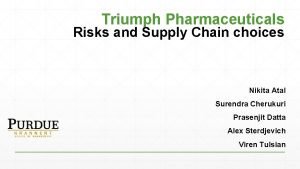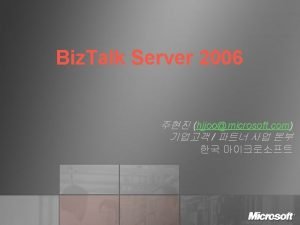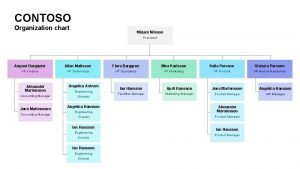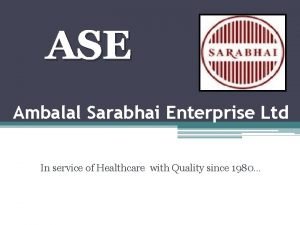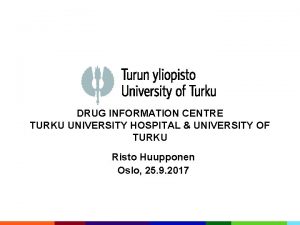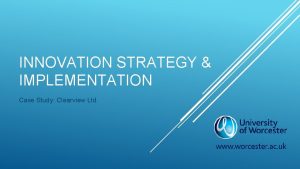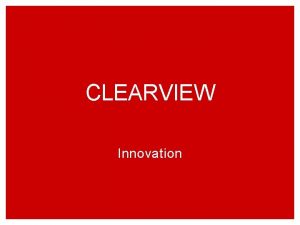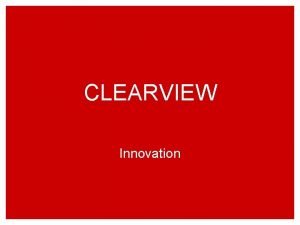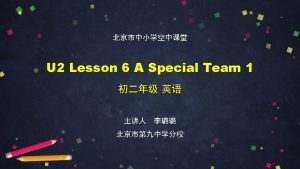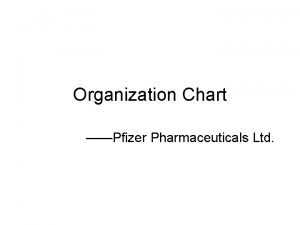Case Study Clearview Pharmaceuticals Innovation Team Clearview Pharmaceuticals


















- Slides: 18

Case Study: Clearview Pharmaceuticals – Innovation Team Clearview Pharmaceuticals is a small manufacturing company. The innovation team is responsible for mainly process innovations and includes key personnel from all of the main functions in the organisation – all managers and some specialists. They meet b-monthly to discuss the progress of their goals and review the status of various projects. They also review any ideas which have been generated by employees that match organisation goals. Clearview Pharmaceuticals mission is ‘to manufacture world class eye care solution products’. The team has identified four major stakeholders – conformance bodies, their parent corporation, their customers and corporate shareholders. Clearview Pharmaceuticals have created a stategic plan to help them meet the requirements of their stakeholders. Their plan is concise and is divided into five change areas or strategic thrusts. One thrust involves changes to the ebusiness infrastructure of the organisation and points at changes to ebusiness systems development in general and shop floor data collection in particular The requirements of each stakeholder has been carefully determined and is monitored regularly by one of the team. A key requirement of customers is reducing manufacturing lead times. At each meeting the Production Manager gives an update to the rest of the team on the status of this requirement. As new requirements are determined they are added an appropriate strategy agreed.

Case Study: Clearview Pharmaceuticals – Innovation Team The team has selected eight performance indicators which are reviewed each month. All of these indicators indicate progress towards meeting the objectives of the organisation. The team has agreed firm and stretch targets of performance for the end of the year. All indicators currently have a ‘green light’. There a number of ideas being harvested at present and the team have ranked them according to their level of impact and level of risk in achieving their stated impact. The stimuli which generated the idea are monitored. Some ideas will become projects, others will be merged with existing projects, many more will be shelved or rejected outright. Each project is analysed according to the payback period equal to capital cost divided by savings or revenue minus recurrent cost. Projects are also ranked according to impact on goals and level of risk. The team reviews the project portfolio monthly. Each project is also linked or associated with a number of goals indicating which goals a particular project is addressing.

Case Study: Switch. IT Ltd. – Management Team Switch. It Ltd. Is a self owned design and manufacturing company of electrical switch gear. All managers form a team which reviews their development plan weekly. As part of the creation of their plan they initially created statements around their strengths, weaknesses, threats and opportunities. They have also created statements for mission, vision, quality, safety and core competencies. The management team has identified six stakeholders for the company including ‘Employees’ and the local ‘Community’. Their existing customer requirements are for increased product availability and reduced order lead times. The team has a set of strategic objectives for development over the period of one year. Nine strategic areas or thrusts have been defined with a number of individuals objectives or strategies per area. The areas have been labelled around the major functions in the organisation including Design, Finance, Engineering, Manufactring and so on. The IT function for example has three strategic thrusts around the areas of keeping abreast of ‘latest technologies’, migrating some processes towards an ‘ecommerce’ platform and improving ‘accessibility’ to database information for users on the shop floor.

Case Study: Switch. IT Ltd. – Management Team The team has selected six performance indicators which are reviewed each week. Absenteeism measures the monthly absenteeism rate for their manufacturing processes. E- Enquiries measures the number of enquiries that come in from customers over the companies ecommerce systems. Each of the performance indicators is performing well and a number have associated charts that show more explicit details. The company currently has a number of ideas under investigation and number have recently been translated into active projects. There are nine projects in the companies project portfolio and each has been ranked. One project ‘Website’ is requiring attention and the personal responsible ‘Andrew Kelly’ has indicated the %Complete of the project. The management team has created a number of relationship matrices including projects versus the impact horizon (i. e. immediate, tactical and strategic)

Case Study: LCIT Solutions – Business Development Team This IT service company’s goal is to provide high quality IT services and products that satisify customer needs. Its business development team consists of personnel of different levels from various functional departments: from managing director to manager to member, from technical group to HR team to financial department. The board members meet monthly to discuss major issues of the company. Furthermore, technical seminars are held irregularly for technical staff in order to keep up with the latest technology. Other groups also have meetings at intervals to review specific issues. The team has created statements of mission. The team also has summarised the strengths, weaknesses, opportunities and threats of the company The team has identified five stakeholders, including customers, employees, government, organisation and suppliers. The requirements of the stakeholders are monitored and regularly reviewed by the responsible team. A key requirement of customers is customer satisfaction. After careful selection, eight strategic areas or thrusts have been determined. There are one or several individual objectives in each area. For example, good customer relations and customer feedback are two branches in the strategy of customer focus.

Case Study: LCIT Solutions – Business Development Team The team has chosen eight performance indicators. For example, the Defects per Installation measures the errors in each installation. Although the company is trying to keep the errors to a minimum but they do often occur. A record of these is kept to help solutions to stop this happening in the future. All these indicators are performing well except one need attention, training. The development team has created a number of relationship matrices including projects versus the impact horizon (i. e. immediate, tactical and strategic) Several ideas on have been created by the company, in the issues of marketing, training and information systems and so on. These ideas are being translated into actual projects. The issue of white finger prevention particularly requires urgent attention. There are ten projects in the companies project portfolio and each has been ranked, the progress of the project is also given with the complete percentage. Several projects currently require attention.

Case Study: Bell Medical Devices - Quality Systems Development Team Bell medical Devices is a manufacturing company produces medical devices. A team has been formed for the development of the quality systems. The goal of the development team is to manage the company’s quality system effectively, efficiently and compliantly. Members of the team come from various functional departments of the company, including quality, design, production, human resource and financial department. Given were the statements for the missions, strengths, weaknesses, threats and opportunities. Especially there is the environmental statement, which emphasises the protection of our environment is of primary importance to Bell Medical Devices. Minimising environmental impact, minimising the depletion of finite natural resources and the prevention of pollution form the foundation of our environmental policy. The team has identified four stakeholders, namely corporation, customer, employees and regulatory bodies. Emphasis were put into the requirements of the corporation, including improving the visibility of the Quality System function, improving quality/consistency of Quality System documentation. Five strategy areas or thrusts were selected. There are twelve objectives in total under these five areas. In the area of Harmonisation of Quality System across Corporation, three objectives can be observed.

Case Study: Bell Medical Devices - Quality Systems Development Team After careful selection, six performance indicators have been determined. All indicators have associated charts that show more explicit details. However, there are only two indicators are performing well at this moment, the other four more or less require attention. A large number of ideas have been generated by the team. All these ideas have been ranked as well. The stimuli area of each idea has also been identified. Some of these ideas have been translated into actual projects. Six projects have been put into the company’s project portfolio. the progress of the project is also given with the complete percentage. The project of Improved Documentation Change Control system currently need urgent attention. And the project of Harmonisation of Quality Systems Departments also requires some attention at this stage.

Case Study: Cybelia - Information Technology Development Team In order to realise its initiative of the development of the Management Information System (MIS), Cybelia Ltd. has set up an IT development team. The company has assigned a project manager to lead the team. Members of the team are specialised in the areas of programming, web development, system analysis, system administration, technical support, human resource and training. Particularly, the Chief Information Officer of the company has involved in this IT development team to ensure timely and effective communication between the management team of the company and the IT development team. The company’s mission is to provide solutions for the extended digital enterprise. The team has identified five stakeholders, namely conformance, maintenance, quality standards training. There are totally nineteen requirements under these stakeholders. For example, several ISO standards were listed as the requirements of Quality Standards, to guarantee the system in high quality. In addition, the maintenance of the system has included requirements on System Auditing, Web Updating, hardware & Software, Programming Design & Development. Four strategic areas or thrusts have also been selected, including benchmarking, maintenance, organisation and planning. The objectives under different strategic areas are dealing with concerns from different aspects of the development of the system. For example, the thrusts of benchmarking and maintenance are initiatives from the technical point of view of the development of the system, including hardware, software and equipments. While objectives under organisation are focused on the issues of the implementation of the system.

Case Study: Cybelia - Information Technology Development Team Eight performance indicators are determined in order to monitor the results of the development of the system. Currently, three of the eight indicators more or less require attention from the team. For example, the item of Response Time, which measures the duration of the period between problem notification and rectification when responding to a system going down, needs further reduction. Eight ideas have been created by the team. However, only three of the ideas are performing well. The progress each idea towards completed has also been given in percentage. Moreover, the decision on each idea has also been given, which includes pending, merging and creating new project. There are in total twenty project undergoing with the development team at this stage. Particularly, the project of software architecture has only been complete 12% in terms of progress, thus need urgent attention from the team.

Case Study: Design Development Portfolio - Product Development Team Personnel from different functional departments with different specialities have formed a product development team performing the company’s product innovation activities. Innovation through teamwork is the mission of the team. Members of the team meets in high frequency to discuss the company’s product development from various points of view, review completed tasks and assign new tasks. The team has created statements for many purposes. For example, in the statement of quality, the company has claimed that “quality in our organisation is a state of mind”, and “it is our enlightened self-interest to make customer interaction with our company so positive that they will choose working with us over any alternative”. The product development team has identified four stakeholders, namely conformance, corporate, critical internal factors and customer. Some key requirements from the company’s internal factors have been given special attention, including reducing number of iterations, increasing number of training hours per employee, launching new products on time and promoting graduate recruitment. Five strategic areas or thrusts have been selected by the team, involving various aspects of the development of the product. Some are focused on the radical changes on product development, while others are about innovation on the company’s culture, improving the platform environment, and employing new technologies, etc. For example, besides the objective of developing new core products, the company is also considering develop knowledge management system improve knowledge share across the company.

Case Study: Design Development Portfolio - Product Development Team There are twentyeight performance indicators which have been determined by the team. Here it is shown only ten of the indicators. Less than half of the indicators are performing well The development team has created ten relationship matrices, including a number of terms versus projects, and several other terms versus initiatives. Eight ideas have been generated by the team. Some of the ideas have been or will be translated into new projects. However, the rest four are somehow pending. Particularly, the idea of product Take. Back need urgent attention from the team. Fourteen projects are currently being carried out by the team. Most of the projects are going on well, while four of them need attention. Several projects are performing particularly well, as the responsible personnel have indicated 100 for the %Complete. On the contrary, the poorest project has only been completed 10%.

Case Study: EMS Implementation - Environment Development Team This company provides environmental service for the recycling of woods waste. An environment development team has been formed to implement an Environmental Management System (EMS) and develop the existing quality system of the company. The team is headed by the company’s managing director, and has been empowered by the participation of several managers, engineers and financial consultants. The team has create statements for the company’s SWOT. The company’s mission is to provide best class service in wood waste recycling. Particularly, the team has identified two opportunities for the company: the waste recycling market is steadily growing and resources to recycle other waste streams. Four stakeholders have been selected by the team, namely customer, employees, government bodies and owners. There are seventeen requirements in total from these stakeholders, and customers’ and employees’ requirements have been given special attention. The team has also agreed on five strategic thrusts for the company. The employment of information technology has been identified to be an important ways for the growth of the company’s business. On the issue of the EMS, three objectives should be reached, including the generation and implementation of an EMS, identification of the environmental impacts and complying with environmental policy.

Case Study: EMS Implementation - Environment Development Team Eight performance indicators have been determined by the team to monitor and assess the actions. It can be observed that all these indicators are performing very poor currently, and need attentions, some do need urgent attentions from the team. The team has generated four ideas. Unfortunately, all these ideas are currently performing very poor and need urgent attention from the team. The decision on these ideas including creating new projects, generating draft and carrying out investigation. Six projects are undergoing at this stage. These projects are ranked according to impact on goals and level of risk. Two of the market research analysis projects, which are the responsible of Fergus Griffins and Kate Collins respectively, have not been indicated a %Complete progress and thus require urgent attention. The team has created a number of relationship matrices including projects versus the impact horizon (i. e. immediate, tactical and strategic), projects versus requirements, projects versus strategies, projects versus indicators.

Case Study: OHS&S Management System – H&S Development Team The team for the development of the company’s Occupational Health, Safety and Sustainability (OHS&S) Management System is formed by managers, supervisors and coordinators from different functional departments. The mission of the team is to provide a safe and secure working environment for its employees. To initialise the plan, the team has created statements for the mission and vision, identified their strengths, weaknesses, opportunities and threats. Three stakeholders have been considered, including conformance, corporate and critical internal factors. The requirements of each stakeholder have also been determined. And a responsible person has been assigned to each requirement. The team meets every a couple of weeks to discuss the development of the company’s OHS&S management system, review completed tasks and assign new tasks. A series of standards have been selected as the guide lines for the development of the OHS&S management system. These standards have covered six aspects, to which should be given special attention during the development of the system. These standards include Initial Status Review, OHS&S Policy, Planning, Implementation and Operation, Checking and Check Correction Action and Management Review. A responsible person has also been assigned to monitor the execution of each standard.

Case Study: OHS&S Management System – H&S Development Team The team has selected six performance indicators, all of which are reviewed every quarter. All of these indicators indicate progress towards meeting the objectives of the organisation. The team has agreed firm and stretch targets of performance. The status of these indicators currently are either “require urgent attention” or “require attention”. The team has generated a number of ideas. The team has made a decision for each idea. The status of how actual projects are generated from these ideas have also been indicated. The team has created a number of relationship matrices including Requirements versus Projects There are nine projects associated with the ideas. All of them have been ranked. Three of the projects currently “require attention”, while the rest are performing well.

Case Study: Theme Park Design Group - Services Development Team This company is an entertainment company that markets, designs and operates medium sized theme parks. The design group takes the design demands of own company from R&D department, and design contracts for other companies from the marketing department as input. And then it generates output as features and theme parks design for the operation department, and features design for other companies. The team is formed by a group of designers under the leadership of Theme Park Manager and Feature Manager, who report to the manager of the department. Members of the team meet every other week to review their work. The team has determined six stakeholders, including the company headquarters, conformance bodies, cooperation partners, marketing department, operations department and R&D department. There are eleven requirements from these stakeholders. Particularly, there is a requirement of requiring sufficient design specifications from the stakeholder of cooperation partners. The team has identified seven strategic areas or thrusts. And there are one or more objectives under each strategy. The strategies cover the issues of the group’s core business (i. e. theme park and feature design), employment of new technologies, the group’s organisation and harmonisation with other departments, cooperation with peer companies, and so on. An important point in the overall strategy is that the design should reflect local culture.

Case Study: Theme Park Design Group - Services Development Team There are seven performance indicators to monitor and assess the design group’s work. All of these indicators indicate progress towards meeting the objectives of the organisation. The team has agreed firm and stretch targets of performance for the end of the year. The team has generated ten ideas and have ranked them according to their level of impact and level of risk in achieving their stated impact. A decision has been made for each idea. Some of these ideas have been translated into projects. Seventeen projects are undergoing within the design group. The progress of each project has been indicated in %Complete by the responsible person.
 Clearview middle school
Clearview middle school Innovation for the sake of innovation
Innovation for the sake of innovation Incremental innovation vs disruptive innovation
Incremental innovation vs disruptive innovation Best case worst case average case
Best case worst case average case Crm failure case study
Crm failure case study Going native project management
Going native project management Team spirit becomes team infatuation
Team spirit becomes team infatuation The white team cheers for the blue team, just like
The white team cheers for the blue team, just like Nikita atal
Nikita atal What is contoso
What is contoso Contoso pharmaceuticals
Contoso pharmaceuticals Contoso pharmaceuticals
Contoso pharmaceuticals Contoso presentation
Contoso presentation Contoso pharmaceuticals
Contoso pharmaceuticals August bergqvist
August bergqvist Ambalal sarabhai pharmaceuticals products
Ambalal sarabhai pharmaceuticals products Vddi cardio
Vddi cardio Edict pharmaceuticals
Edict pharmaceuticals Newbury pharmaceuticals keskustelu
Newbury pharmaceuticals keskustelu








